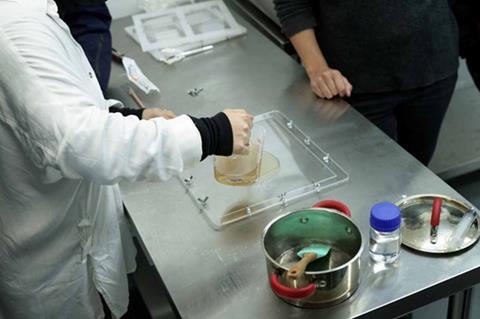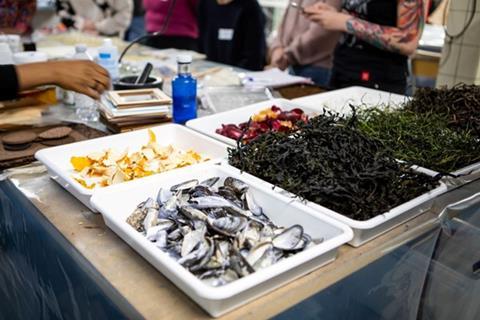
The Principles of Green Chemistry are designed to help chemists make safe and sustainable choices for human and environmental health. Today, companies, governments, and higher education systems are integrating them into curricula and practice across the packaging industry. Dr. Charlene Smith, Green Chemistry Lead at Materiom, shares her views on the role of green chemistry in regenerative materials innovation in the packaging space.
Can you tell us about your background and the work you do at Materiom?
Yes, absolutely. I have a PhD in inorganic chemistry focused on single-molecule magnets and nanotechnology, which is very small-scale chemistry for the innovation of smart materials. I then transposed this expertise to prioritise green chemistry practices through regenerative research and development using biopolymers, looking at materials that work with the earth’s natural ecology.
At Materiom, I implement green chemistry practices in the development of novel, compostable biomaterials, fine-tuning their properties based on their intended application or functionality – for instance, formulating hard, soft or flexible composite materials. These provide businesses, entrepreneurs, startups, and green chemistry practitioners examples that guide green chemistry biomaterial making from the beginning of their practice.
Why green chemistry?
For me the trigger was fully understanding the impact of the materials I was initially using to create smart applications: the exhaustive use of solvents – harsh acids and bases – where the yields are very, very small, but the formulation process still requires extraction through large amounts of very toxic or corrosive materials.
This started to have an effect on me in the sense that I would ask myself, “if I’m just one chemist in a lab, and this is going on all over the world, from desk research, to manufacturing, to large-scale factories, how much of this is being emitted into our atmosphere and our environments?”
That notion prompted me to explore regenerative and green chemistry practices that don’t necessarily require the exhaustive use of heat or pressure, or acute corrosive chemicals. We only have one planet and we are living in a world of accelerated innovation.
Why do we have to resort to toxic, fossil-fuel-based materials when we can use this innovation to work alongside nature, rather than against it? It sounds so simple, but nature has been evolving for billions of years; it’s managed to withstand what we’ve thrown at it, it’s evolved, it’s created new capabilities and capacities to survive. If we look all around us, a lot of tools have been provided to us if we use biomimetics. Nature’s innovation is the most sophisticated innovation we have, so why don’t we use that to help us make high-performance materials?

As a green chemist, what do you consider when designing a new material?
What we aim to do at Materiom – and in my role as a green chemist – is look at materials from the beginning of the design process, right through to the end of life. So at the beginning, we look at what potential impact a material will have on a particular localised ecosystem – each component of the material system has to be considered, whether that’s the volume, location and method in which biomass is sourced; or the solvent used (in green chemistry, water is a predominant solvent); or how that solvent interacts with all the ingredients used.
Then we also look at how the materials will break down into their original building blocks, so that we can re-use them to make new materials or understand their nutrient value within compost for soil environments.
Processes, including low pressure and low heat, and solvent use are key for green chemists – not only looking at the material components, but also the methods and energy used in development.
Key research questions we ask ourselves, particularly with the scale-up aspect of material development, are: if a particular solvent is being used and it’s not water, how can that solvent be recaptured in a closed-loop system? By using green chemistry can we minimise the negative effects of that material on the environment?
As a chemist, it’s quite easy to get lost in the conventional, pragmatic – quite analytical – way of thinking. What green chemistry has taught me is to be more intuitive with approaches to material making. We place value on how to adapt our research discipline to think about the systemic aspects of material making – not just the end product and any associated aesthetics, but how these materials would work symbiotically with the local environment around us.
What are some of the biggest challenges or obstacles the industry needs to overcome?
We have been locked in for so long in terms of conventional or traditional methods using technical, petrochemical materials. There is a misconception that these are the most advantageous or the most high-performing materials that can be discovered, whereas we can create these high-performing materials using biopolymers from renewable sources.
Spider silk is pound-for-pound stronger than steel. We need to challenge misconceptions about how biomaterials and biomimetics can perform against fossil fuel-derived materials, which is difficult when it may serve to undo a lot of the current business models and infrastructure of these larger multinational businesses who are seemingly locked into using petrochemical-based materials.

Another aspect is understanding the application and designing a material fit for that specific purpose. Most everyday packaging products, condiment packaging for example, do not need to last for hundreds of years - we only need them to last a matter of days.
So, if we can create, for example, biofilms to encase these products that can then biodegrade to provide nutrients to soil and marine environments, it seems like a no-brainer. It’s actually working symbiotically, serving our needs as consumers, and those of our local natural ecological systems. Once we start to change perceptions around this, then producers, manufacturers, industry, and policymakers will give more attention and funding to biomaterial development as a primary focus.
Another challenge is scale-up. It’s one thing being in a wet lab or a prototyping lab (which of course is essential and necessary for initial development), but when we’re talking about understanding how that looks for scale-up, how those materials perform on a mass-produced scale, they can sometimes operate differently. For example, when things work well with water at a prototyping stage, we may need to look at other green solvents that are more suited to scale-up.
You recently co-authored a research paper on bioplastics and the circular economy - can you share a brief overview of what you found?
This particular research paper was primarily a toxicology and environmental impact study on a series of bioplastics (biofilms specifically) made from gelatin, chitin, and seaweed-based biopolymers, to see how they interact with different environments when they break down. It was done in collaboration with the University of Exeter, and the findings revealed that these biomaterials have considerably low persistent and low acute toxicity, so that they can be deemed environmentally safe. In terms of ecotoxicology, they do not emit any disruptive elements to biodiversity.
Which essentially opens up the potential for these particular materials to be used in a diverse range of biomaterial applications as alternatives to petrochemical materials, but also encourages the development of safer materials by design. The next step would be to look at the additive nutrient potential of these materials, but this first step was to verify that they are non-toxic and safe to use environmentally.

Imagine I am a packaging designer or manufacturer – what advice would you give me if I am starting out on this journey and want to explore the use of green chemistry in my innovation process?
Build a picture of the whole lifecycle: start by asking where you are sourcing your materials from – is your feedstock renewable? Can it be found in abundance from a variety of sources? Can you ensure its sustainability? Can it be derived from waste streams or secondary sources?
Look at analogous materials or reports that centre around those particular feedstocks and understand if they serve your desired function. How have they been used before - if at all? Then look at how those component building blocks might affect the potential for breakdown or biodegradation at end of life. Will they disrupt or support the localised ecology?
Understand the functionality: With packaging, how flexible does it need to be? What is the intended use? Does it need any extra plasticizers such as glycerol, which is quite a common one to use for flexibility and biofilms?
Or does it need to be reinforced with other biomaterials such as cellulose, which can act as a great reinforcement and found in all plant-life matter. Or can it have aspects of, for example, sawdust chips to create a more robust and hard surface? How long does the material need to exist? Does it need to last three days or three weeks?
Experiment: In addition to your background research on what’s been done before, test the material in various different environments, keeping the experiments controlled. Go back to basics ensuring you are recording the temperature in the room, humidity, etc. keeping everything uniform so that if you were to repeat the experiment, or the methods again, you will know exactly what aspects you’ve changed to arrive at the optimum version of the formulation.
If you liked this article, you might also enjoy:
The Lidl approach to packaging sustainability
How did Brazil achieve its 100% aluminium can recycling rate – and can it be replicated in the EU?
Experts have their say on the EU’s Packaging and Packaging Waste Directive revisions
A deep dive into the most important packaging sustainability trends and solutions












No comments yet